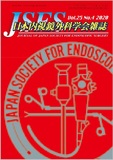Japanese
English
- 有料閲覧
- Abstract 文献概要
- 1ページ目 Look Inside
- 参考文献 Reference
◆要旨:腹腔鏡補助下脳室腹腔シャント術は成人では広まりつつあるが,小児の報告は未だ少ない.当科で施行した5例の手術手技の要点を報告する.まず,体格の小さい小児の周囲に多数の人員・機材を配置するため,互いに干渉しないよう注意が必要であった.初回手術では2ポート,再建時など腹腔内の癒着がある場合は単孔式3ポートとした.新生児ではスコープ・鉗子ともに臍部ではなく側腹部から挿入した.皮下を通したパッサーは,直接腹腔内へ挿入した.シャントチューブは屈曲しないように鉗子で誘導し,シャントの開通も腹腔鏡で確認した.手術合併症は認めなかった.手技の定型化により,成人と同様な有用性が示されることが期待される.
In adults, there has been a shift towards laparoscopic-assisted peritoneal shunt insertion for ventriculoperitoneal shunt surgery. However, there have been a limited number of reports in Japan regarding the use of this technique in children. Here, we describe our surgical technique performed in five children. Since many doctors and nurses are involved in the management of a small child and many surgical devices are necessary, great care had to be taken to prevent interference with one another. Two trocars were inserted in primary shunt surgery. In cases with intraperitoneal adhesions, such as revision shunt surgery, single-incision surgery with three trocars was performed. In neonates, both the scope and forceps were inserted from the flank, rather than the umbilicus. The passer was introduced from the head through the subcutaneous tissue directly into the peritoneal cavity. The shunt tube was guided through the passer with forceps in order not to bend it, and the opening of the shunt was confirmed with the laparoscope. No surgical complications were observed in our series. Standardizing this procedure would lead to establishing the usefulness of laparoscopic-assisted peritoneal shunt insertion in children as in adults.

Copyright © 2020, JAPAN SOCIETY FOR ENDOSCOPIC SURGERY All rights reserved.


